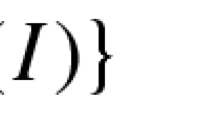Abstract
In this article, we study the evolution of open inextensible planar curves with hinged ends. We obtain long time existence of C ∞-smooth solutions during the evolution, given the initial curves that are only C 2-smooth with vanishing curvature at the boundary. Moreover, the asymptotic limits of this flow are inextensible elasticae. Our method and result extend the work by Wen (Duke Math. J. 70(3):683–698, 1993).
Similar content being viewed by others
References
Angenent, S.: On the formation of singularities in the curve shortening flow. J. Differ. Geom. 33(3), 601–633 (1991)
Antman, S.S.: Nonlinear Problems of Elasticity, 2nd edn. Applied Mathematical Sciences, vol. 107. Springer, New York (2005)
Bryant Robert, R., Griffiths, P.: Reduction for constrained variational problems and \(\int\frac {1}{2}\vec{\kappa}^{2}ds\). Am. J. Math. 108(3), 525–570 (1986)
Brunnett, G., Wendt, J.: Elastic splines with tension control. In: Mathematical Methods for Curves and Surfaces, II, Lillehammer, 1997. Innov. Appl. Math., pp. 33–40. Vanderbilt Univ. Press, Nashville (1998)
Cannon, J.R.: The One-Dimensional Heat Equation. Encyclopedia of Mathematics and Its Applications, vol. 23. Addison-Wesley, Reading (1984). Advanced Book Program. With a foreword by Felix E. Browder
Dall’Acqua, A., Pozzi, P.: A Willmore–Helfrich L 2-flow of curves with natural boundary conditions. Commun. Anal. Geom. 22(4), 617–669 (2014)
Dall’Acqua, A., Lin, C.-C., Pozzi, P.: Evolution of open elastic curves in \(\mathbb{R}^{n}\) subject to fixed length and natural boundary conditions. Analysis (Berlin) 34(2), 209–222 (2014)
Dall’Acqua, A., Lin, C.-C., Pozzi, P.: A gradient flow for open elastic curves with fixed length and clamped ends. Preprint (2014)
Dziuk, G., Kuwert, E., Schätzle, R.: Evolution of elastic curves in \(\mathbb{R}^{n}\), existence and computation. SIAM J. Math. Anal. 33(5), 1228–1245 (2002)
Gage, M., Hamilton, R.S.: The heat equation shrinking convex plane curves. J. Differ. Geom. 23(1), 69–96 (1986)
Golomb, M., Jerome, J.: Equilibria of the curvature functional and manifolds of nonlinear interpolating spline curves. SIAM J. Math. Anal. 13, 421–458 (1982)
Hearst, J.E., Shi, Y.: The elastic rod provides a model for DNA and its functions. In: Mathematical Approaches to Biomolecular Structure and Dynamics, Minneapolis, MN, 1994. IMA Vol. Math. Appl., vol. 82, pp. 59–70. Springer, New York (1996)
Koiso, N.: On the motion of a curve towards elastica. In: Actes de la Table Ronde de Géométrie Différentielle, Luminy, 1992. Sémin. Congr., vol. 1, pp. 403–436. Soc. Math. France, Paris (1996)
Langer, J., Singer, D.A.: Curve straightening and a minimax argument for closed elastic curves. Topology 24(1), 75–88 (1985)
Langer, J., Singer, D.A.: Lagrangian aspects of the Kirchhoff elastic rod. SIAM Rev. 38(4), 605–618 (1996)
Lin, C.-C.: L 2-flow of elastic curves with clamped boundary conditions. J. Differ. Equ. 252(12), 6414–6428 (2012)
Linnér, A.: Some properties of the curve straightening flow in the plane. Trans. Am. Math. Soc. 314(2), 605–618 (1989)
Mumford, D.: Elastica and Computer Vision, West Lafayette, IN, 1990. Algebraic Geometry and Its Applications, pp. 491–506. Springer, New York (1994)
Novaga, M., Okabe, S.: Curve shortening–straightening flow for non-closed planar curves with infinite length. J. Differ. Equ. 256(3), 1093–1132 (2014)
Oelz, D., Schmeiser, C.: Derivation of a model for symmetric lamellipodia with instantaneous cross-link turnover. Arch. Ration. Mech. Anal. 198(3), 963–980 (2010)
Oelz, D.: On the curve straightening flow of inextensible, open, planar curves. SeMA Journal 54, 5–24 (2011)
Polden, A.: Curves and surfaces of least total curvature and fourth-order flows. Ph.D. dissertation, Universität Tübingen, Tübingen, Germany (1996)
Starostin, E.L., van der Heijden, G.H.M.: The shape of a Möbius strip. Nat. Mater. 6, 563–567 (2007)
Wen, Y.: L 2 flow of curve straightening in the plan. Duke Math. J. 70(3), 683–698 (1993)
Wen, Y.: Curve straightening flow deforms closed plane curves with nonzero rotation number to circles. J. Differ. Equ. 120(1), 89–107 (1995)
Willmore, T.: Curves. In: Handbook of Differential Geometry, vol. I, pp. 997–1023. North-Holland, Amsterdam (2000) (English summary)
Acknowledgements
During working on this project, C.-C. Lin was supported by the National Science Council of Taiwan NSC 101-2115-M-003-002 and the National Center for Theoretical Sciences in Taipei, Taiwan; and Y.-K. Lue was supported by MOST 103-2811-M-003-008. The authors also want to thank the referees for useful comments and corrections toward improving the presentation of this article.
Author information
Authors and Affiliations
Corresponding author
Appendix
Appendix
Lemma 13
Let \(\ell\in\mathbb{N}\), and
Then, under the assumption in Lemma 10, \(\gamma_{\ell}: D_{0}^{b}\rightarrow\mathbb{R}\) is well-defined for any ℓ∈{1,2,…,m+1}. Moreover, for any δ∈(0,t), the following properties hold,
where \(C_{\ell}^{\prime\prime}(b, \delta)\) is a constant.
Proof
Note that since \(\varphi\in\mathfrak{B}_{b}^{L}(d_{0},M_{0})\), we may apply (3.34), (3.32), (3.33), and (3.20), and verify easily that, for any ℓ∈{1,2,…,m},
for all \((\xi,\tau)\in D_{\delta}^{b}\), \((\xi_{i},\tau) \in D_{\delta}^{b}\), i∈{1,2}, and some positive constants C(ℓ,b,δ). For convenience, we may assume without loss of generality that, for fixed ℓ and b, C(ℓ,b,δ)↗+∞ as δ↘+0.
From the definition of fundamental solution K in (3.12), it is easy to verify that K is infinitely differentiable in \(\mathbb{R}\times(0, \infty)\) and its derivatives of any order is uniformly bounded in \(\mathbb{R}\times[\epsilon, \infty)\) for any fixed ϵ>0. In fact, for any \(k\in\mathbb{N}\),
where \(P_{t}^{k}(x)\) is a polynomial of degree k whose coefficients depend continuously on t and could tend to infinity only if t→+0. From using (4.6), it is easy to verify that, for any fixed t>0, \(s\in\mathbb{R}\), and t 1,t 2≥0,
where the constant C K (k,t)→+∞ as t→+0.
To show (4.1) when ℓ∈{1,2,…,m+1}, observe that, with a change of variables and an integration by parts with respect to the space variables,
for any fixed ϵ′∈(0,t). Note that, for any fixed τ∈(ϵ′,t), one can infer from (4.6) and (3.20) that the integrand in the last term is null. As we continue to integrate by parts in (4.9), using (4.4) and the property of exponentially vanishing rate of \([\partial_{s}^{j}K](x, t^{\prime})\), we obtain that
for any ℓ∈{1,2,…,m+1} and any fixed ϵ′∈(0,t). Now, (4.1) follows on applying (3.20), (4.4), (4.7), and (4.8). Furthermore, since (4.1) holds for any δ∈(0,b), \(\gamma_{\ell}: D_{0}^{b}\rightarrow\mathbb{R}\) is well-defined.
To show (4.2), we use the formula (4.10) and write
for some fixed ϵ′∈(0,t). The first integral in (4.11) can be rewritten as
For fixed t,τ satisfying t−τ≥t−ϵ′>0, one can conclude from (4.6) and (3.20) that the function \(K_{(t,\tau)}^{m+2}(\xi,s):=\partial_{s}^{m+2} K(s-\xi,t-\tau) \cdot (h\circ\varphi)(\xi,\tau)\) is uniformly bounded, integrable over the subset \(\mathbb{R}\times [s_{1},s_{2}]\subset\mathbb{R}^{2}\) and
By using Fubini’s Theorem, the integral in (4.12) can be written as
The second integral in (4.11) can be written as
by the change of variables, ξ′=ξ−Δs, where Δs:=s 2−s 1≥0. Thus, by applying (3.20), (4.7) to the integral (4.14), and by applying (4.5), (4.8) to the integral (4.15), we obtain
Therefore, (4.16) implies the continuity of γ m+1 in the domain \(D_{0}^{b}\) along the s-direction, i.e., we have proved (4.2).
To show (4.3), we only need to prove the continuity of γ m+1 at any point in \(D_{0}^{b}\) along the t-direction, because of the result in (4.2). Now, for a fixed t 1∈(0,b), we assume that ϵ>0 satisfies
and choose t 2≠t 1 so that
From using (4.10), we write
By the property \(\partial_{t} K(x,t)=\partial_{x}^{2} K(x,t)\), the first integral in (4.19) can be written as
For fixed \(s\in\mathbb{R}\), τ∈[0,t 1−ϵ], one can conclude from (4.6) and (3.20) that the function \(L_{(s,\tau)}^{m+3}(\xi,t):=\partial_{s}^{m+3} K(s-\xi,t-\tau) \cdot (h\circ\varphi)(\xi,\tau)\) is uniformly bounded, integrable over the subset \(\mathbb{R}\times [t_{1},t_{2}]\subset\mathbb{R}^{2}\) and
By using Fubini’s Theorem, we may rewrite the integral in (4.20) as
By applying (4.7), (4.17), (4.18), we note that t−τ≥ϵ/2 in the integrand of (4.22) and thus
Denote the second integral in (4.19) by I 2. Then, by applying (4.4), (4.8), (4.18), we obtain
Similarly, we may denote the third integral in (4.19) by I 3 and obtain
Notice that sup t∈[ϵ/2,b]{C K (m+3,t)}→+∞, as ϵ→+0, while C(m,b,t 1−ϵ) in (4.24) and (4.25) would remain bounded as ϵ→+0. Now, for any sufficiently small ϵ>0, we choose any t 2∈(t 1−ϵ/2,t 1+ϵ/2) such that
Then, from (4.23)–(4.25), we obtain
where |Δt|:=|t 2−t 1|<ϵ/2. Now, we have the continuity of γ m+1 along t-direction at any point in \(D_{0}^{b}\). Thus, the proof of (4.3) is obtained. □
Proof of Lemma 10
We want to show that
Let
Note that, for fixed t∈(0,b] and fixed ϵ∈(0,t), J ϵ (⋅,t) is smooth over \(\mathbb{R}\), and we may exchange the operation of differentiation and integration below,
Then, for any fixed t∈(0,b] and ℓ∈{1,2,…,m+1}, we first show that, on any bounded and closed interval of \(\mathbb{R}\),
Observe that, from (4.10), choosing sufficiently small ϵ>0 so that t−ϵ>δ>0, and applying (4.8), we have
Thus, over any compact subset \([s_{0}, s]\subset\mathbb{R}\) and for any fixed t∈(0,b],
as ϵ→+0. Moreover, γ ℓ (⋅,t) is uniformly continuous on [s 0,s], for all ℓ∈{1,2,…,m+1}.
Now, we prove (3.37) by induction argument. Namely, we assume that
Notice that, as ℓ=0, the equality holds by the definition of function γ ℓ . Since
∀ℓ∈{1,…,m}, fixed t∈(0,b], and sufficiently small ϵ>0. By letting ϵ→+0 and applying (4.27) in (4.29), we derive
By applying (4.28) to the L.H.S. of (4.30), we obtain
Then, by applying the fundamental theorem of calculus above, we have proved (4.26).
The proof of Lemma 10 is now completed by using an induction argument on m, and applying Lemma 13 and (4.26). Note that when m=1, (3.34), (3.32), (3.33) hold from the fact that \(\varphi\in\mathfrak{B}_{t_{0}}\), for some t 0∈(0,b 0], and applying Lemma 6. □
Rights and permissions
About this article
Cite this article
Lin, CC., Lue, YK. & Schwetlick, H.R. The Second-Order L 2-Flow of Inextensible Elastic Curves with Hinged Ends in the Plane. J Elast 119, 263–291 (2015). https://doi.org/10.1007/s10659-015-9518-5
Received:
Published:
Issue Date:
DOI: https://doi.org/10.1007/s10659-015-9518-5
Keywords
- Geometric flow
- Second-order parabolic equation
- Hinged boundary conditions
- Elastic energy
- Willmore functional




